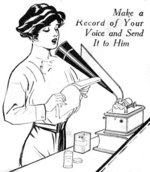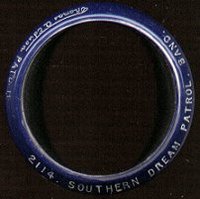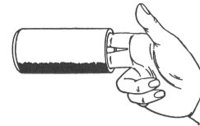Phonograph cylinder
|
|
The earliest method of recording and reproducing sound was on phonograph cylinders. Commonly known simply as "records" in their era of greatest popularity (c. 1888 - 1915), these cylinder shaped objects had an audio recording engraved on the outside surface which could be reproduced when the cylinder was played on a mechanical phonograph. The competing disc shaped gramophone record system triumphed in the market place to become the domininent commercial audio medium in the 1910s, and commercial mass production of phonograph cylinders ended in 1929.
CylinderRecordsWPackage.jpg
| Contents |
Early development of the phonograph cylinder
The very first recordings in the 1870s by Thomas Edison were done on the outside surface of a strip of tinfoil wrapped around a rotating metal cylinder. By the 1880s wax cylinders were mass marketed. These had sound recordings in the grooves on the outside of hollow cylinders of slightly soft wax. These cylinders could easily be removed and replaced on the spindle of the machine which played them. Early cylinder records would commonly wear out after they were played a few dozen times; the buyer could then either bring the worn cylinders back to the dealer be traded in as partial credit for purchase of new recordings, or have their surface shaved smooth so new recordings could be made on them.
Early cylinder machines of the late 1880s and the 1890s were often sold with recording attachments. The ability to record as well as play back sound was an advantage to cylinder phonographs over the competition from cheaper disc record phonographs which began to be mass marketed at the end of the 1890s, as the disc system machines could be used only to play back pre-recorded sound.
Edison1907AdFamilyDance.jpg
In the earliest stages of phonograph manufacturing various competing incompatible types of cylinder recordings were made, but in the late 1880s a standard system was decided upon by Edison Records, Columbia Phonograph, and other companies; these were about 4 inches (10 cm) long, 2¼ inches in diameter, and played about two minutes of music or other sound.
Commercial packaging
EdisonSlip1902.jpg
Image:EdisonSlip1902.jpg
Cylinders were sold in cardboard tubes, with cardboard lids at each end. These containers helped protect the recordings. These containers and the shape of the cylinders (together with the "tinny" sound of early records compared to live music) prompted the nickname canned music. Record companies usually had a generic printed label on the outside of the cylinder package, with no indication of the identity of the individual recording inside. Early on such information would be written on the labels by hand, one at a time. Slightly later, the record number would be stamped on the top lid, then a bit later the title and artist of the recording would be printed on to labels on the lid. Shortly after the start of the 20th century, an abbreviated version of this information (together with the name of the record company) would be printed or impressed on to one edge of the cylinder itself. Previously the actual cylinders had no such visual identification. However they would have a spoken announcement of the song or performance title, recording artist, and record company recorded on to the beginning of the recording.
ColumbiaCylLabelPortion.jpg
Small paper inserts were with the recording information and placed inside the package with the cylinders. At first this was hand written or typed on each slip, but printed versions became more common once cylinders of certain songs were sold in large enough quantities to make this economically practical. Note in the example in the image on the right, from Edison Records, 1902, the consumer is invited to cut out the circle with printed information. This paper circle could then be pasted either to the lid of the cylinder container, or (as this example prompts) to a spindle for this cylinder in specially built cabinets for holding cylinder records which were marketed by record companies. Only a minority of cylinder record customers purchased such cabinets.
Further improvements of commercial cylinders
Over the years the type of wax used in cylinders was improved and hardened so that cylinders could be played over 100 times. In 1902 Edison Records launched a line of improved hard wax cylinders marketed as "Edison Gold Moulded Records".
Edisongoldmoulded.jpg
Hard plastic replaces wax
In 1906 the Indestructible Record Company began mass marketing cylinder records made of celluloid, an early hard plastic, that would not break if dropped and could be played thousands of times without wearing out. This hard inflexible material could not be shaved and recorded over like wax cylinders, but had the advantage of being a nearly permanent record. (Such "Indestructible" style cylinders are arguably the most durable form of sound recording produced in the entire era of analogue audio before the introduction of digital audio; they can withstand a great number more playbacks before wearing out than such later media as the vinyl record or audio tape.) This superior technology was purchased by the Columbia Phonograph Company. The Edison company then developed their own type of long lasting cylinder, consisting of a type of plastic called Amberol around a plaster core, these were called Amberol cylinders. Around the same time Edison introduced 4 minute cylinders, having twice the playing time of the old standard cylinder, achieved simply by shrinking the groove size and spacing them twice as close together in the spiral around the cylinder. Most (but not all) Amberol cylinders are of the four-minute variety. Edison phonographs for playing these improved cylinder records were called Amberolas. See also: Blue Amberol Records.
Cylinders versus discs
In the era before World War I phonograph cylinders and disc records competed with each other for public favor.
The audio fidelity of a sound groove is not inherently better if it is engraved on either a disc or a cylinder, and the competition was due to other factors.
Advantages of cylinders
The cylinder system had certain advantages. As noted, wax cylinders could be used for home recordings, and "indestructible" types could be played over and over many more times than the disc. Cylinders usually rotated at a greater speed than discs, creating a greater linear velocity of the stylus in the groove, which in theory would give an advantage of better audio fidelity. Around 1900 cylinders on average are indeed of notably higher audio quality than contemporary discs, but as disc makers improved their technology by 1910 the fidelity differences between better discs and cylinders became minimal.
Cylinder phonographs also usually used a worm gear to move the stylus in synchronization with the grooves of the recording, whereas most disc machines relied on the grooves to pull the stylus along. This resulted in cylinder records played a number of times having less degradation than discs, but this added mechanism made cylinder machines more expensive.
Advantages of discs
Both the disc records and the machines to play them on were cheaper to mass-produce than the products of the cylinder system. Disc records were also easier and cheaper to store in bulk, as they could be stacked, or when in paper sleeves put in rows on shelves like books.
Most cylinder phonographs had a weakness in the belt used to turn the spinning spindle; slight slippage of this belt produces the audio "wobble" characteristic of cylinders played back on original equipment. Disc phonographs using a direct system of gears did not have this problem; the heavy metal turntable of disc machines acted as a flywheel, helping to minimize speed wobble.
In 1908 Columbia Records introduced mass production of disc records with recordings pressed on both sides, which soon became the industry standard. Patrons of disc records could now get two recordings for less than the price of one on cylinder.
Mention should also be made of the superior advertising and promotion done by the disc companies, most notably by the Victor Talking Machine Company in the United States and the Gramophone Company/HMV in the Commonwealth. Great singers like Enrico Caruso were hired to record exclusively, helping put the idea in the public mind that that company's product were superior.
The end of cylinders
Cylinder recordings continued to compete with the growing disc record market into the 1910s, when discs won the commercial battle. In that decade Columbia (which had been making both discs and cylinders) switched exclusively to discs, and Edison started marketing their own disc records. However Edison continued to sell new cylinder records to consumers with cylinder phonograph machines through 1929. The latest of the new cylinders were simply dubs of disc records, and as such are of lower fidelity than the disc versions.
Later application of phonograph cylinder technology
Cylinder phonograph technology continued to be used for dictaphone recordings for office use into the early 1950s when the cylinder dictaphone was supplanted by magnetic tape.
References
- From Tin Foil to Stereo: Evolution of the Phonograph by Oliver Read and Walter L. Welch, Howard W. Sams & Co. In,c Indianapolis, Indiana, 1976. ISPN 0-672-21206
- The Edison Cylinder Phonographs 1877 - 1929 by George L. Frow and Albert F. Sefl, George F. Frow, Sevenoaks, Kent, 1978. ISBN 0 9595462 3 2
External links
- Tinfoil.com (http://www.tinfoil.com/) — History of phonograph cylinders; listen to many examples dating from 1878 through 1912
- Phonograph cylinders (http://www.btinternet.com/~bill78/cylinder.htm) on Bill Clark's 78rpm Record site
- http://www.geocities.com/fiddlindon/Col_Phono.html Bob Morritt`s Columbia Phonograph Company Cylinder Records Site
- How did they mass produce those old cylinder records? (http://www.straightdope.com/classics/a1_256b.html)
- Phonograph Maker's Pages (http://members.chello.se/christer.hamp/phono/) How to make your own cylinder player with electric output.
- The three surviving Edison cylinders (http://www.nps.gov/edis/cylinder_desc.htm) on the National Recording Registry with descriptions, audio and transcripts.de:Wachszylinder





